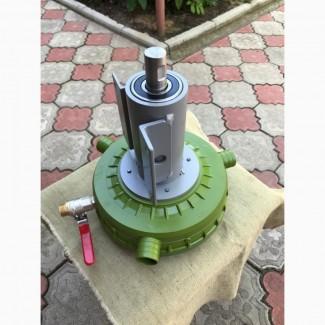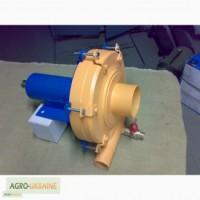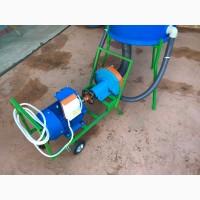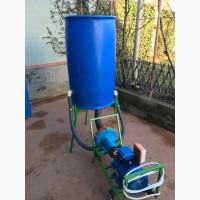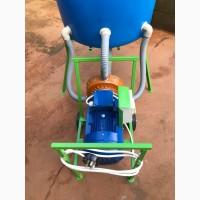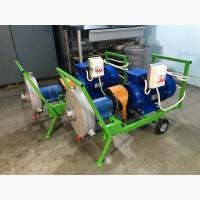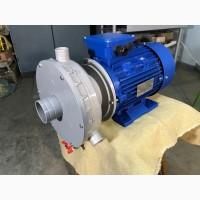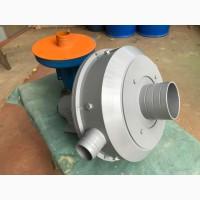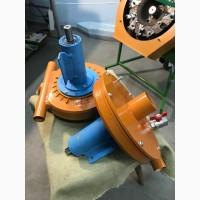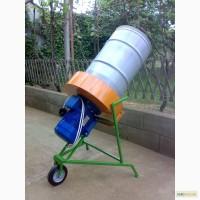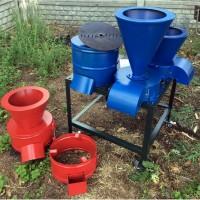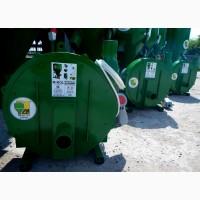/ Agricultural machinery, equipment, inventory / Preparation of fodder (equipment) / Crushers, fodder shredders / Crusher, grain crusher, hydromill "...
For sale / buy
Grain grinder, grain crusher, hydromill "Appetite GM 5B", Mykolaivska region.
Price14,000 UAH.
Region:
Mykolaiv region.
(G.Nikolaev)
Updated:
Aggregate will help increase weight gain and milk yield, save on feed, avoid expensive additives, make fattening and keeping pets and birds more profitable.
Not one of the well-known methods of preparing fodder from grain - dry grinding, flattening, steaming, extrusion... does not give fodder of the same quality as GM processing.
Hydromill - ГМ5Б (Б-without engine) - from water and any grain, from millet to corn, weed seeds... with additives of sunflower meal, crushed alfalfa... prepares hot fodder porridges, used for fast, economical fattening and keeping pigs, cattle, rabbits, domestic animals, chickens, ducks, sheep, dogs, and other domestic animals and birds.
Having GM5B, you can make a feed processor of your own design and feed 100 or more piglets, while saving up to 40 tons of grain compared to dry feeding (crushed grain + water trough). To do this, you need to have an email. a 5-7 kW engine, which rotates the GM activator through the clutch and has a capacity of 100-300 liters. The small size and weight of ГМ5Б significantly reduces the cost of shipping to the buyer. Delivery to any address in Russia and Kazakhstan is arranged.
The porridge preparation cycle is 30-45 minutes, it depends on the amount and temperature of the water used, grain preparation**... To prepare the porridge, water, milk waste is poured into the hopper... The unit is turned on and into the bubbling water, one part of grain is poured into 2-3 parts of water. GM works like apump - it sucks water from the bunker, passes it through itself and returns it back. The rotating activator grinds the grain, provokes cavitation*, which heats the composition, decomposes the fiber and other components of the grain into components that are easily digested by the animal's intestines. Cereal starch partially changes to a form that is easier to digest - sugar. The result is hot, sweetened porridge. Tasteless straw flavored with it is eaten quickly and with appetite! - the "clean trough" effect.
That. the main "digestion" of grain does not occur in the stomach, but in the hydromill, due to electric energy and the cavitation process. Animals and birds can easily digest "chewed" food without expending energy, hence the increase in egg production, weight gain, and improvement in their general condition. Up to 90% assimilation of fodder reduces the amount of manure, cavitation disinfects porridge, destroying bacteria introduced from the field and during grain storage.
The technologies of economical feeding are based on the maximum preparation of fodder, when the stomach of the animal spends minimal effort for its assimilation, the main work is performed by the equipment. GM successfully solves this problem, and wet feeding technology has the best performance, compared to dry and extruded. In any case, warm, liquid food is more physiological and friendly to the animal's stomach than dry food!
Technical details of the unit:
-- recommended drive ГМ5Б - engine with a capacity of 5-7 kW/2860 rpm;
-- steel wear-resistant activator with heat hardening;
-- stuffing box - an end seal made of silicon carbide;
-- bearing unit - bearings 62305 2RS (2 pcs.);
-- the recommended volume of the bunker is 100-300 liters;
-- diameter of the inlet pipe – 60 mm; - outlet diameters nozzles (3 pcs.) – 32 mm;
-- total weight - 12 kg.
Advantages of using GM and wet feeding technology:
(//tractor-service.com)
-- saves up to 50% of grain, ideal mixing of additives!
-- porridge is prepared from any available grain, weed seeds!
-- full or partial refuse premixes, high-quality meat and fat!
-- fodder mixture when heated to 50˚C retains maximum biological value!
-- in the process, cavitation* disinfects feed - bacteria introduced from the field and during storage die, i.e. the use of moldy, contaminated feed components is possible! -- disinfection prevents diseases, including diarrhea!
-- up to 6-7 months, instead of 10-12, the fattening period is shortened. The opportunity to grow up to two generations of animals per hour on one area.
-- facilitates the work of the animal breeder, saves space, time, electricity. energy, there is no need to buy compound feed, which is 30-40% more expensive than grain.
-- operation of GM is profitable, because one unit replaces several units of equipment and works as: grinder, mixer, heater, steamer, homogenizer...!
-- grinding in water is economical, less power is required with minimal wear!
-- the opportunity to prepare food for many animals and birds with one unit!
-- prepares brew for quality moonshine!
Some reviews from users:
-- Ruslan, Odesa region. - I am raising the second generation of piglets with a hydromill. If he spent about 1000 kg with dry feeding, now - 600 kg of grain mixture for fattening one piglet. After selling the meat, buyers paid attention to its high quality. Piglets gain weight faster, and the savings of 400 kg for 24 piglets is almost 10 tons of grain mixture. Ot premixov refused.
-- Vladimir, Kharkiv region - For many years, I worked at a collective farm as a veterinarian, performed by Gos. orders for growing and fattening animals. There was constant death of young animals in large numbers after feeding them with dry fodder, which swelled the animals' stomachs. After the purchase of a hydromill, for an auxiliary farm, I was clearly convinced that pigs grow faster, feed consumption became less.
In the photo: the ГМ5B hydromill and the "Appetite-300" feed processor in which it is used, prepares up to 300 liters per time. fodder porridge Кроме этого есть ГМ5 - monobloc - el. 5.5 kW/3000 rpm engine with GM on the shaft - a compact device with a high degree of readiness. The last picture of ГМ15Б is a unit for a feed mill with a capacity of up to 1000 liters of porridge per hour.
Thank you for your interest. Any questions about the use of the unit, purchase, payment, delivery - voka1953@gmail.com tel: +38 067 2825117 +38 095 3505197 Viber, WhatsApp; skype voka531
* Cavitation is a process that destroys solids in a liquid - ship propellers, workerspump wheels... In our case, it decomposes grain, sterilizes the substance without boiling, killing spores and bacteria.
** The prepared grain is crushed, flattened, and the best option, as practice shows, is soaked or even germinated. Additional work pays off with a significant economic effect.
Not one of the well-known methods of preparing fodder from grain - dry grinding, flattening, steaming, extrusion... does not give fodder of the same quality as GM processing.
Hydromill - ГМ5Б (Б-without engine) - from water and any grain, from millet to corn, weed seeds... with additives of sunflower meal, crushed alfalfa... prepares hot fodder porridges, used for fast, economical fattening and keeping pigs, cattle, rabbits, domestic animals, chickens, ducks, sheep, dogs, and other domestic animals and birds.
Having GM5B, you can make a feed processor of your own design and feed 100 or more piglets, while saving up to 40 tons of grain compared to dry feeding (crushed grain + water trough). To do this, you need to have an email. a 5-7 kW engine, which rotates the GM activator through the clutch and has a capacity of 100-300 liters. The small size and weight of ГМ5Б significantly reduces the cost of shipping to the buyer. Delivery to any address in Russia and Kazakhstan is arranged.
The porridge preparation cycle is 30-45 minutes, it depends on the amount and temperature of the water used, grain preparation**... To prepare the porridge, water, milk waste is poured into the hopper... The unit is turned on and into the bubbling water, one part of grain is poured into 2-3 parts of water. GM works like apump - it sucks water from the bunker, passes it through itself and returns it back. The rotating activator grinds the grain, provokes cavitation*, which heats the composition, decomposes the fiber and other components of the grain into components that are easily digested by the animal's intestines. Cereal starch partially changes to a form that is easier to digest - sugar. The result is hot, sweetened porridge. Tasteless straw flavored with it is eaten quickly and with appetite! - the "clean trough" effect.
That. the main "digestion" of grain does not occur in the stomach, but in the hydromill, due to electric energy and the cavitation process. Animals and birds can easily digest "chewed" food without expending energy, hence the increase in egg production, weight gain, and improvement in their general condition. Up to 90% assimilation of fodder reduces the amount of manure, cavitation disinfects porridge, destroying bacteria introduced from the field and during grain storage.
The technologies of economical feeding are based on the maximum preparation of fodder, when the stomach of the animal spends minimal effort for its assimilation, the main work is performed by the equipment. GM successfully solves this problem, and wet feeding technology has the best performance, compared to dry and extruded. In any case, warm, liquid food is more physiological and friendly to the animal's stomach than dry food!
Technical details of the unit:
-- recommended drive ГМ5Б - engine with a capacity of 5-7 kW/2860 rpm;
-- steel wear-resistant activator with heat hardening;
-- stuffing box - an end seal made of silicon carbide;
-- bearing unit - bearings 62305 2RS (2 pcs.);
-- the recommended volume of the bunker is 100-300 liters;
-- diameter of the inlet pipe – 60 mm; - outlet diameters nozzles (3 pcs.) – 32 mm;
-- total weight - 12 kg.
Advantages of using GM and wet feeding technology:
(//tractor-service.com)
-- saves up to 50% of grain, ideal mixing of additives!
-- porridge is prepared from any available grain, weed seeds!
-- full or partial refuse premixes, high-quality meat and fat!
-- fodder mixture when heated to 50˚C retains maximum biological value!
-- in the process, cavitation* disinfects feed - bacteria introduced from the field and during storage die, i.e. the use of moldy, contaminated feed components is possible! -- disinfection prevents diseases, including diarrhea!
-- up to 6-7 months, instead of 10-12, the fattening period is shortened. The opportunity to grow up to two generations of animals per hour on one area.
-- facilitates the work of the animal breeder, saves space, time, electricity. energy, there is no need to buy compound feed, which is 30-40% more expensive than grain.
-- operation of GM is profitable, because one unit replaces several units of equipment and works as: grinder, mixer, heater, steamer, homogenizer...!
-- grinding in water is economical, less power is required with minimal wear!
-- the opportunity to prepare food for many animals and birds with one unit!
-- prepares brew for quality moonshine!
Some reviews from users:
-- Ruslan, Odesa region. - I am raising the second generation of piglets with a hydromill. If he spent about 1000 kg with dry feeding, now - 600 kg of grain mixture for fattening one piglet. After selling the meat, buyers paid attention to its high quality. Piglets gain weight faster, and the savings of 400 kg for 24 piglets is almost 10 tons of grain mixture. Ot premixov refused.
-- Vladimir, Kharkiv region - For many years, I worked at a collective farm as a veterinarian, performed by Gos. orders for growing and fattening animals. There was constant death of young animals in large numbers after feeding them with dry fodder, which swelled the animals' stomachs. After the purchase of a hydromill, for an auxiliary farm, I was clearly convinced that pigs grow faster, feed consumption became less.
In the photo: the ГМ5B hydromill and the "Appetite-300" feed processor in which it is used, prepares up to 300 liters per time. fodder porridge Кроме этого есть ГМ5 - monobloc - el. 5.5 kW/3000 rpm engine with GM on the shaft - a compact device with a high degree of readiness. The last picture of ГМ15Б is a unit for a feed mill with a capacity of up to 1000 liters of porridge per hour.
Thank you for your interest. Any questions about the use of the unit, purchase, payment, delivery - voka1953@gmail.com tel: +38 067 2825117 +38 095 3505197 Viber, WhatsApp; skype voka531
* Cavitation is a process that destroys solids in a liquid - ship propellers, workerspump wheels... In our case, it decomposes grain, sterilizes the substance without boiling, killing spores and bacteria.
** The prepared grain is crushed, flattened, and the best option, as practice shows, is soaked or even germinated. Additional work pays off with a significant economic effect.
|
Author, contacts | |
Владимир / reviews, info.: 1 / activity evaluation | |
|
Phone:
+38 xxxxxx
show
| |
| Skype: voka531 | |
All user ads ~15 | |
Ad ID: #462287
(added by a registered user, registration date: 10-01-2013)
Added / Updated: 07-10-2025 15:18 (current, until: 07-10-2026)
Permanent Ad Address:
Impressions / views for today: ?, total: ?
Similar ads
Among them there are many interesting ones...
Filters: Grain crushers
Total106 similar adsin the section "Crushers, feed shredders"
All Ukraine: Agricultural machinery, equipment, inventory 48273 / Forage preparation (equipment) 400 / Crushers, fodder shredders 106
Mykolaiv Region: Agricultural machinery, equipment, inventory 500 / Forage preparation (equipment) 14 / Crushers, fodder shredders 9
